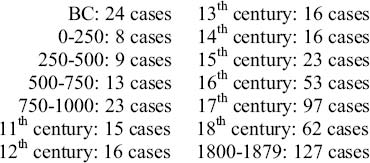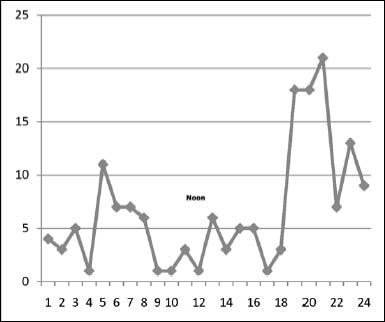Wonders in the Sky (103 page)
Read Wonders in the Sky Online
Authors: Jacques Vallee
For further researchâ¦
It is vital to recognize the magnitude of the progress that the opening up of archives online has made possible in this research. This fact also contributes to distorting the statistics about the data: since pre-1800 texts cannot easily be read by optical character recognition scanning software, the amount of information available to us after 1800 has become mountainous in comparison to older records. Those researchers who believe that the UFO phenomenon started manifesting on Earth around that time are simply misled by the fact that our information sources are far more abundant and more readily available after the eighteenth century.
Pre-1800 often means important but damaged records, unreadable or unpredictable script, dirty or flaking paper, fewer surviving sources, and no keyword search possibilities. It also means, in consequence, that such material is of little interest commercially, so what is available online is much less than what exists in the real world. Oddly enough, Egyptian records three or four millennia old, which were carved in the stone of stelae, preserve a more complete story than some of our yellowing nineteenth century American newspapers. We know what Akhenaton saw and heard in 1378 BC, but we have serious uncertainties about the whereabouts of the Post Office building in Jay, Ohio after 1858.
Anyone complaining that we should go out and search archives and libraries page by page has no idea how much time it takes, how hard on the eyes it is, and how hit-and-miss it can be. Some brave early researchers like Dr. Bullard have spent decades looking for old cases, compared to what the Internet-based Magoniax Project collected in just a few years. The digitizing of text has given us this gift. We can breathe new life into aerial phenomena research, just as the same sources can improve knowledge in other academic fields.
As we complete the first edition of this book, we are painfully aware that many sources remain beyond our grasp or even beyond our knowledge, because they are still buried in faraway libraries, written in languages with which we are not familiar, or even undeciphered in the dusty backrooms of museums. We are especially lacking in reliable data from Japan, China, and India, all ancient civilizations where careful records were kept down through the ages. We hope that scholars in those countries will be inspired to teach us about the knowledge preserved in their libraries. Our fervent hope is that the present book may stimulate scholars to dig out such material and bring it to the light of modern review, to inform our search for meaning among phenomena that still puzzle our best scientists today.
First, a word of disclosure: as authors of this compilation, we have worked with the awareness that we could not escape projecting some of our own beliefs, and those of the Western society of the 21
st
century to which we belong, through the case selections we have made.
Â
The cement holding the reports together is based on two components: on the one hand, some selection and research criteria we have tried to disclose with clarity; and on the other, our faith that the majority of the sightings belong in the same group and are not fictional. This already carries a perceptible message: we believe that most of the witnesses we quote did in fact observe phenomena that have remained unexplained to this day.
Twelve important questions
At this point in our exploration of the mysteries of the past, the reader is entitled to ask: what have we learned from all this work, how significant are the findings, do they teach us anything new about the modern phenomena generally called “UFOs” and is there more yet to be discovered? We will examine these topics systematically, and present our analysis as a series of twelve specific questions.
1. How homogeneous is this Chronology of 500 cases?
The Chronology is only homogeneous by virtue of the selection criteria the authors have applied after casting a very broad net over the literature, and throwing back the little fish, the crustaceans, and the rotten algae back into the sea. We kept approximately one case in five or ten, depending on the period and context. Our screening parameters, which demanded a search for original references, a date and location, served to enhance the quality of the data and promoted cases that came from reliable records over popular rumors.
Having done this, we screened out the items where we could find no compelling reason to think the phenomena described were
other than
meteors, aurorae borealis, ball lightning, tornadoes or other unusual atmospheric effects. In spite of this effort, the Chronology remains biased across time. We have more information on 19
th
century incidents than medieval observations, as the following graph shows.

Fig. 70: Case distribution by period
The historical statistics break down as follows:

2. Isn't the Chronology biased by your own cultural backgrounds?
Undoubtedly it is. As disclosed above, we know much more about France or England than about Japan or China. The two authors share a background in Western humanities and the tradition of scientific enquiry that represents a selection bias against unfamiliar Asian, African, Polynesian, or Native American sources, especially those embedded in the imagery and texts of pre-1900 societies.
Most contemporary students of unidentified flying objects posit that the phenomenon is of recent origin and centers on the Anglo-Saxon world simply because it became popular in the American press after World War Two. While we have avoided this pitfall, we cannot claim expertise in using sources in cultures other than our own. Thus, given two fragmentary rumors about similar events in medieval France and in a remote part of Asia, we are more likely to invest time and effort in tracking down the more accessible French reference, because of its more familiar linguistic and historical context, than the Asian one. We are also more likely to view the Asian story through a skeptical filter because of possible mistakes in translation and an absence of cultural references. This bias could only be corrected by researchers from other cultures joining in this effort.

Fig. 71: Case distribution by country
The geographical statistics break down as follows:

3. Do these cases represent a global phenomenon?
As one reads through the chronology from end to end, two things become clear: (a) no convenient natural phenomenon or combination of natural phenomena accounts for the collection of events we have selected, although some alternative explanations may be proposed for individual cases and (b) the same unexplained features occur again and again, often in the same words in the language of witnesses.
The overwhelming fact is that we are dealing with a narrow range of anomalous objects in the atmosphere or in space, typically described as spheres, balls, or disks, capable of extraordinary trajectories, generally of significant duration, often in formation, described by multiple observers and viewed as important enough to be reported to authorities (religious, administrative, or scientific). These features do characterize the events in all countries and all periods.
4. Is this all there is?
Certainly not! Even in regions such as Western Europe, which produced most of our current data, there must be much published (but unscanned) material we have not been able to reach, and there must be large amounts of reports buried in manuscript form in local archives, unpublished personal diaries and private correspondence.
5. Who are the witnesses?
They represent a cross-section of the population, with a preponderance of scientists or enlightened amateurs of “natural philosophy” after 1750 or so. Not surprisingly, given the nature of medieval society, most of the cases involved multiple witnesses, often an entire village or two. Other cases involved the crews of ships, even groups of soldiers at war, and in a couple of sightings, a king with his retinue. Single-witness cases did happen, of course, and religious interpretations were common, but this does not detract from the major facts of the observations.
6. Could all this be simply delusionary?
No, although delusions are a factor in the interpretation of the phenomena, as we have abundantly documented in Part II of this book. Psychological or anthropological explanations fail to account for most of the cases selected in the Chronology. In fact, the so-called “rational” explanations proposed by academic experts are often as delusionary as the most fanciful reports, and they fail to account for the observed facts in the same way.
Given the preponderance of multiple-witness cases, and the many events attested by figures in authority such as astronomers, State or Church representatives, as well as the extensive investigations some of the events have triggered, it is not reasonable to claim that no physical phenomenon of an unusual nature was present.

Fig. 72: Frequency of cases as a function of duration
Furthermore, a review of the duration of the sightings (known to us in 106 cases) shows that most of the objects or phenomena were in sight for a considerable time, certainly long enough for the witnesses to have called other people, and to have ascertained the circumstances of the observation.
Â
The duration statistics (above chart) are as follows:

Such a distribution is not typical of delusionary events or hallucinations.
7. Are there general patterns behind the sightings?
We have only begun to study this body of data for possible patterns. In particular, the time of day is known or at least estimated with some precision (plus or minus one hour) for no less than 205 cases, or 40% of the total.
The resulting distribution is consistent with the results of similar studies conducted on the basis of catalogues of contemporary UFO sightings (notably in the book
The Edge of Reality
by Dr. J. Allen Hynek and Dr. Jacques Vallee, Chicago: Contemporary Books, 1975, page 20): the frequency of reported cases rises before dawn, with a first peak about 6 A.M., and goes through a maximum between 8 P.M. and 10 P.M., returning to a low level during the night.
During most of the day, sighting frequency remains around the noise level. While this can be interpreted as an indication of the visibility of the phenomenon (most clear in contrast with its surroundings when the sun is not present) and a consequence of most people going inside after dark, it does indicate that a real phenomenon was present. Hallucinations or hoaxes would have no reason to follow the same pattern.
